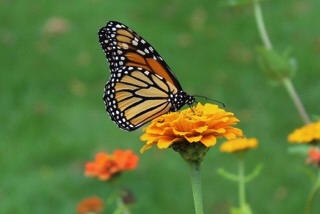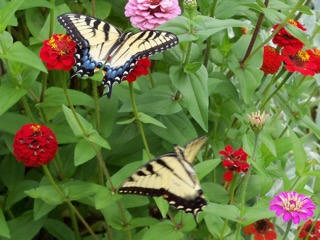
(11/7) In the world of the garden, size and looks matter. If you are a serious gardener, you probably already know all about the importance of pollinators. Beetles, flies, ants, bees, and butterflies are all pollinators, but which one do you get most excited about spotting in your garden? The butterfly, of course! It’s beautiful…and the bigger the
better! There are lots and lots of tiny butterflies out there, but I barely notice. Show me a great big swallowtail or monarch, and I get very excited!
On a recent day in mid-October, I spied a good bit of fluttering activity up in the garden. When I walked up to investigate, I found no less than seven to ten monarchs taking time out from their long, fall journey south to nectar on my big patch of zinnias. I see occasional single monarchs in my garden during the summer, but ten at once… I had
never seen that before! I knew they were migrating, and that they travel in groups. Of course, I had my camera in hand, and I took a good many pictures of the beautiful insects and wished them luck on their flight for the next 2000 miles!
Did you know that those delicate creatures fly all the way from as far north as Canada, through Texas and into the high mountains of central Mexico where they cluster together in trees to pass the winter?
 An astonishing fact is that even though, during the summer, each individual butterfly lives only about two weeks, the individual monarch who starts north in the spring is the very one who flew south last fall and survived the winter months in Mexico. Although other species of butterflies
move south for warmer climates during the winter months, the monarch is the only butterfly known to make a two-way migration as birds do.
An astonishing fact is that even though, during the summer, each individual butterfly lives only about two weeks, the individual monarch who starts north in the spring is the very one who flew south last fall and survived the winter months in Mexico. Although other species of butterflies
move south for warmer climates during the winter months, the monarch is the only butterfly known to make a two-way migration as birds do.
Sweet nectar from flowers, and sometimes sap from trees, is the sustenance of butterflies. Butterflies will nectar on almost any flower, especially those with rather flat landing pads such as coneflowers, black-eyed Susans, Tithonia (Mexican sunflower), and daisies. In my experience, one of their favorites is the zinnia. Each year, I buy a pack or
two of zinnia seeds (I like the Cut and Come Again mixture), and I plant them right in the soil after danger of frost has past. I keep them damp until they establish themselves, which doesn’t take very long. After that I don’t baby them. They will hold up well to drought and heat. Once the first flush starts to fade (about early August), I do a little deadheading, which
keeps fresh blooms coming longer. This year, I had constant blooms from early June through frost.
 Another favorite butterfly that loves the zinnias is the resident eastern tiger swallowtail. ‘Resident’ refers to the fact that these butterflies do not migrate. Their caterpillar forms a chrysalis right near your garden and hangs out all winter until it emerges in the spring. These
butterflies are yellow with black stripes. The females have a large swath of blue across their lower wings, and of course, all swallowtails have their distinguishing two tails. Did you know that they got their name from a familiar bird, the barn swallow, with its similar forked tail?
Another favorite butterfly that loves the zinnias is the resident eastern tiger swallowtail. ‘Resident’ refers to the fact that these butterflies do not migrate. Their caterpillar forms a chrysalis right near your garden and hangs out all winter until it emerges in the spring. These
butterflies are yellow with black stripes. The females have a large swath of blue across their lower wings, and of course, all swallowtails have their distinguishing two tails. Did you know that they got their name from a familiar bird, the barn swallow, with its similar forked tail?
The other swallowtail butterfly common to my garden is the black swallowtail, which has the same attractive tail markings, buts its body is black.
Every butterfly species requires a host plant(s). That host plant is the plant that the baby caterpillar can eat. Without the host plant, the butterfly cannot reproduce. For the monarch, that plant is the milkweed. People have long looked at common milkweed as an undesirable weed, and it is true that it can become a garden thug, meaning it likes to
spread around everywhere. There are, however, other forms of milkweed which are far less problematic. I have some swamp milkweed that is very beautiful and hasn’t spread in six years. The botanical name for milkweed is Asclepius, and the family includes butterfly weed that the monarchs find quite acceptable. Our native butterfly weed is an orange-flowered perennial. It is
smaller, and not nearly so difficult to manage as common milkweed. There is also annual milkweed, which is native to Mexico, and very attractive. It is also high on the desirability list of egg-laying monarch females.
The more versatile eastern tiger swallowtails host on a variety of trees. Some of the common ones are red maple, yellow poplar, black willow, black cherry, American hornbeam, and sassafras.
The black swallowtails, which are a different species from the tigers, (even though some female tigers are black), host on members of the carrot family including parsley, dill, fennel and carrots.
My encounter with all monarchs reminded me of the day, also with camera in hand, I spied a beautiful female eastern swallowtail nectaring on the zinnias. She was being courted by a very althletic male. He was flying rings and loops around her. I actually got a picture of him flying upside down! Finally, she gave in, and together they did flip-flops
across the yard. When it was all over, he went casually off to investigate some coneflowers, and she came back to her zinnias.
Flower gardening is fun, and the results can be beautiful, but gardening for the wildlife is amazing!
Read other articles on birds, wildlife & beneficial insects
Read other articles by Barbara Mrgich